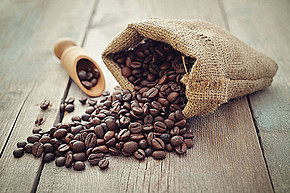Introduction of honey treated Pakamara and water washed Javanica
Follow the caf é (Wechat official account vdailycom) and found that Beautiful Cafe opened a small shop of its own.
Introduction of honey-treated Pacamara and washed Java Nika
Nicaragua NICARAGUA Nicaragua, located in central Central America, is the largest country in Central America, bordering Honduras in the north, Costa Rica in the south, the Caribbean Sea in the east and the Pacific Ocean in the west. The eastern part is the coastal plain, the high temperature and rainy climate belongs to the tropical maritime climate, and the western part is the coastal lowland with more active volcanoes. The north-central part is a highland, with an average annual temperature of 18 ℃ and an annual precipitation of 1500-2500mm. This country in Central America seems too far away for us. Today, we use coffee to get closer to it.

The suitable climate and mineral-rich pozzolanic soil provide an excellent growth environment and abundant nutrients for the cultivation of coffee trees. High-quality Nicaraguan coffee is also grown in the northern and central highlands of the country. The best coffee is produced in Matagalpa. The coffee produced here is highly respected by coffee lovers all over the world and gradually valued by the boutique community. Abundant precipitation, suitable temperature, high altitude, fertile soil and unique planting ecology are the prerequisites for creating high-quality Nicaraguan coffee. (above: volcanic landform) Nicaragua is an economically backward agricultural country and one of the poorest countries in Central America, with high unemployment and poor people. Coffee is a pillar industry in Nicaragua, which produces nearly 100,000 tons of coffee beans every year, but due to the poor economic foundation, the coffee industry is still relatively backward, and coffee farmers are also in a relatively poor state. Although it is the largest country in China and the United States, it is not a big producer in the coffee world, and its output and reputation are much weaker than that of its neighbor Costa Rica. But the high-quality Nicaraguan coffee is in the forefront of coffee beans in the world and enjoys a good reputation. (image above: hand-picked ripe berries) this time we would like to solemnly recommend two kinds of beans that have been very popular in Nicaragua in recent years: Pacamara and Java. These two beans have frequently won prizes in various competitions in recent years, including COE, and have become frequent visitors at international auctions.
Not only has Pacamara shown coffee superstar demeanor, the Java species successfully transplanted in Nicaragua-Java Nika has brought amazement to the coffee world, but also has the tendency to join and surpass the popular varieties (such as Rosa, Pacamara and Yellow Kaduai).
When it comes to coffee estates in Nicaragua, famous estates in the industry include Lemon Tree Manor, God-given Manor and Hope Manor. Since both beans come from the lemon tree manor, this issue will start with the lemon tree manor in Nicaragua.
EL Limoncillo Lemon Tree Manor is located in Matagalpa Plateau, which is also one of the well-known coffee producing areas in Nicaragua. The manor is located on a steep ascent and is rich in water. Walking into the coffee forest, the terrain gradually rises and steepens, and the forest phase also changes from open forest to coniferous forest. because there are many towering coniferous forests around the planted coffee trees, they provide shade for the growth of coffee trees. This allows coffee trees to be exposed to sunlight while protecting them from being burned by the scorching sun. Java is planted according to the topography at 1000 meters above sea level; with the steep topography of the mountain, Pakamara begins to appear, with a height of more than 1300 meters at the top. Excellent micro-climate and excellent soil and water give birth to high-quality coffee.
In order to ensure the quality of coffee, the manual picking method is used to pick the fully ripe fruits one by one, which usually takes three times to complete. Although the manual picking method has high labor cost and low picking efficiency, it can greatly protect the plant from being hurt in the picking process, and the mature fruit will have better sweetness at the same time.
Lemon Tree Manor also processes coffee in a honey-treated way. After the coffee fruit is actually picked, the coffee with its exocarp removed is put on the African shed to dry. Compared with the traditional way of placing coffee directly on the ground to dry coffee, using African shed to dry coffee can reduce more pollution in the drying process, avoid producing more miscellaneous smell, and finally improve the quality of coffee. Honey-treated coffee beans have more attractive tropical fruit flavors. (image above: lemon Tree Manor Steep terrain) (above: Nicaraguan Lemon Tree Manor) # Pacamara # recommendation Index: ★ country: Nicaragua (NICARAGUA) Variety: yellow Pacamara (Yellow Pacamara) Manor: lemon Tree Manor (EL Limoncillo) altitude: 950-1300 m production area: Matagalpa (Matagalpa) treatment: honey treatment (Pulped Natural/Natural Miel) harvest and treatment of Pacamara is less than the common Kaddura and Kaduelho Yellow Pacamara is an occasional product of the interbreeding of traditional Pakamara in the manor, which is very rare, and the Mierisch family should be the first coffee farmer to collect the yellow Pakamara fruit and cultivate it deliberately. At present, it is planted in lemon trees and two estates in San Jose, and the number is still small. At the same time, due to the large shape of Pacamara beans and long oval shape, the process is troublesome whether it is washing or honey treatment after fruit harvest. Peeling machines often need different hole kits, and even the equipment is different. The Pacamara honey of Lemon Manor has the common spice and tropical fruit flavor of Pacamara, not only that, but also with Middle Eastern frankincense and mysterious spice style, tropical fruit is still the same, and there is a unique Eurasian licorice sweet, black tea fragrance, the charm and taste at low temperature is very special, full of exotic flavor. Common flavors include: apricot, vanilla, lemon and citrus, chocolate, tropical fruits (such as mango, pineapple), caramel, sweet spices and so on. (above: Huang Pacamara) # Java #
Recommended Index: ★ country: Nicaragua (NICARAGUA) Variety: Java Nica Manor: lemon Tree Manor (EL Limoncillo) altitude: 950m-1300 m production area: Matagalpa (Matagalpa) treatment: washing (Washed)
Harvesting method: picking by hand, picking ripe cherry fruit one by one
Flavor vanilla, tea, grapefruit, strong greasy; chocolate, tea tree essential oil aroma, black sugar, creamy, nuclear fruit, long-lasting sweetness.
The rise of Java Nika became famous in the first world war. After successfully mixing and developing a unique flavor, the bean won the second place in the 2008 Nicaragua Excellence Cup COE National Competition for the first time. The basic evaluation is: the appearance of beans is beautiful, the flavor after washing is delicate and rich, with the aroma of fruit, vanilla and cream. As a result, Java Nika got more attention.
In addition, since 2010, Lemon Manor has added Java Nica pulp drying method (Pulped Natural, referred to as PN method) and sun treatment, which means that there are two more Java Nika with different flavors. You might as well try it when you have a chance.
Important Notice :
前街咖啡 FrontStreet Coffee has moved to new addredd:
FrontStreet Coffee Address: 315,Donghua East Road,GuangZhou
Tel:020 38364473
- Prev

El Salvador Stone Estate Coffee Bean Introduction
Pay close attention to coffee comment (Weixin Official Accounts vdailycom ) and find a beautiful coffee shop to open its own shop. About El Salvador: El Salvador has about 20,000 small farmers, standing at only 0.9% of the world coffee market, and coffee also refers to 5.1% of the exports of the Warring States Period. Although the sparrow is small, the system of fine coffee is very complete, such as the establishment of the National Coffee Bureau and the laboratory to
- Next

Characteristics of taste and flavor of Nicaraguan coffee planted at altitude
Follow the caf é (Wechat official account vdailycom) found that the beautiful cafe opened a small shop of its own, Nicaragua is one of the main coffee producing countries, produces high quality coffee, even the coffee from the Antigua Mountains of Guatemala, which is famous in Asia, also imports raw beans to Nicaragua. Nicaraguan coffee is not famous in Asia, but in fact, Nepalese coffee is already famous all over the world.
Related
- Detailed explanation of Jadeite planting Land in Panamanian Jadeite Manor introduction to the grading system of Jadeite competitive bidding, Red bid, Green bid and Rose Summer
- Story of Coffee planting in Brenka region of Costa Rica Stonehenge Manor anaerobic heavy honey treatment of flavor mouth
- What's on the barrel of Blue Mountain Coffee beans?
- Can American coffee also pull flowers? How to use hot American style to pull out a good-looking pattern?
- Can you make a cold extract with coffee beans? What is the right proportion for cold-extracted coffee formula?
- Indonesian PWN Gold Mandrine Coffee Origin Features Flavor How to Chong? Mandolin coffee is American.
- A brief introduction to the flavor characteristics of Brazilian yellow bourbon coffee beans
- What is the effect of different water quality on the flavor of cold-extracted coffee? What kind of water is best for brewing coffee?
- Why do you think of Rose Summer whenever you mention Panamanian coffee?
- Introduction to the characteristics of authentic blue mountain coffee bean producing areas? What is the CIB Coffee Authority in Jamaica?

